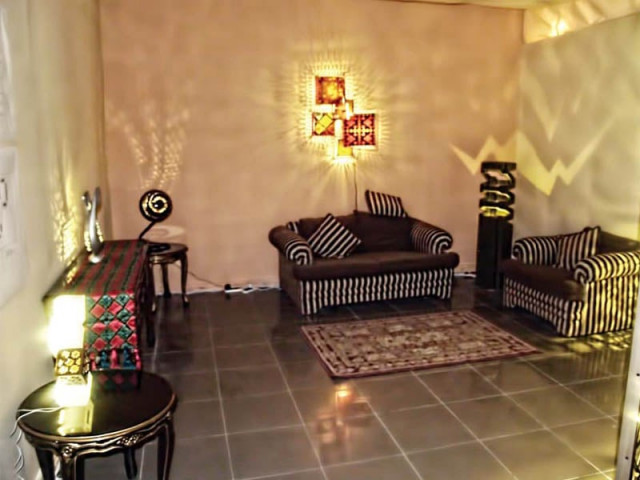Product design: Historical, regional, popular themes find favour
Traditional values inform details of contemporary products like shoes, jewellery and decoration pieces.

One way to preserve heritage is to incorporate its motifs and elements in contemporary art, says Isra Iqbal, a product design master’s student at the National College of Arts.
Iqbal says with her thesis project Illuminating the Craft she has tried to revive the crafts of Swat, her birthplace. “Swati heritage is my identity. I want my heritage to be reflected in my work the way light is reflected from shiny surfaces,” she said to explain her use of light.
She says she has used jisti motif, famous Swati craft, in her work as she has always been fascinated by the geometric patterns and curves of these designs. She has experimented with a range of products for interior decoration such as lamps. She says she has used acrylic, wood, metal, copper and steel as base materials. Most of the lamps used are imported from Italy and some from China, she says.
Iqbal, who has graduated with honours, wants initially to employ her skills in commercial production. She says she may shift to personalised product designing at a later stage in her career.
Shoes with truck art
Maleeha Akram has used truck art in shoe design – a project for which she has received a distinction.
“I always knew my thesis will be about shoes. Shoes have attracted me since my childhood,” she says.
She says the country has a vibrant truck art tradition. Her use of the art form is based on her understanding that it needs to be given a contemporary character. “Truck art in each province in the country has several distinct trends, distinguishing it from truck art in other provinces,” she says. She is most attracted by Punjabi truck art. “It carries a vibrant colour palette with flamboyant patterns,” she says.
Akram says she has spent six months researching for her project. A pair of shoes took from two to three weeks to complete. She has used raw silk, kattan silk and pure silk as fabric base for her shoes.
With a price range of Rs4,000 and Rs12,000, the artist has already managed to sell several pairs.
She hopes to arrange more exhibitions of her shoes in the coming months.
Shahjahan era designs on jewellery
Hira Athar has incorporated patterns from the design of Mughal Era monuments into her jewellery collection. She says she has been inspired by the monuments built during Shahjahan’s reign. She says arts and crafts had flourished the most during Shahjahan’s time. “I am particularly inspired by geometric design elements in monuments like Taj Mahal, Sheesh Mahal, Shalimar Garden and the Shahjahani Masjid,” she says, “I have tried to establish a cultural connection between these designs and modern prodcuts.”
She says it took her eight months to conceptualise the project.
Her products range from rings, earrings and necklaces and took two to three weeks each to complete. She has used brass, lead and copper as base materials and silver-plated the jewellery. The prices of these products range from Rs1,000 for rings to Rs8,000 for necklaces. “Most of my products are for young girls. I have set the prices keeping in mind my target customers,” she said. Athar hopes to soon launch a jewellery brand.
The Sleeping Bus
Muhammad Wasim, a Quetta resident, has designed The Sleeping Bus with an aim to transform public transport sector in the country, making travel by public transport a more comforting experience.
He says his regular commute between Lahore and Quetta inspired the project. “It takes more than a day to travel by road from Lahore to Quetta,” he says, “the level of comfort is an important factor in choosing between different types of transport for long-distance travel.”
Wasim says while trains and buses are the two most popular modes of transport in the country, he chose the latter for his project as comfort level was particularly poor in buses. “In train, there are several compartments with sleeping berths for long-distance commutes,” he points out.
Wasim says the seats in his bus allow passengers to easily change posture.
“It’s a simple concept, yet most transport companies have failed to appreciate it,” he says. His seats have huge drawers underneath which can be used to increase leg room. It can also hold some luggage.
The Sleeping Bus has been designed to accommodate up to 34 passengers and has a toilet facility as well.
Wasim says the manufacturing cost of the prototype seat was around Rs80,000. However, he points out, the price will fall significantly with mass production.
Published in The Express Tribune, January 21st, 2012.


















COMMENTS
Comments are moderated and generally will be posted if they are on-topic and not abusive.
For more information, please see our Comments FAQ